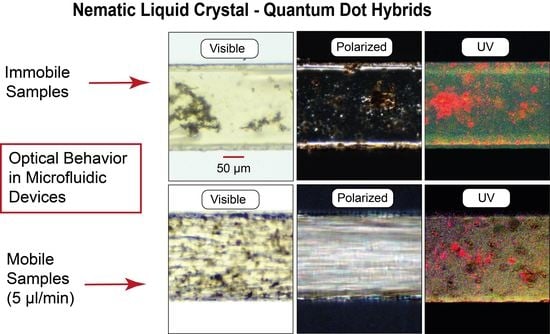Dynamic Flow Control over Optical Properties of Liquid Crystal–Quantum Dot Hybrids in Microfluidic Devices
Abstract
1. Introduction
2. Materials and Methods
2.1. Materials
2.2. Methods
2.2.1. Synthesis of LC-QD Composite and Characterization of Components
2.2.2. Recording and Processing Microscopy Images of Microflows
2.2.3. Fabricating Microfluidic Devices and Preparing Experimental Setup
3. Results
3.1. Preliminary Characterization of LC and LC-QD Composites in Microfluidic Confinement
3.2. Optical Behavior of LC-QD Microflows in Polarized and UV Light
3.2.1. Orientation Behavior of Confined MBBA and MBBA-QD Composite
3.2.2. Luminescence Behavior of MBBA-QD Composite Microflows
3.2.3. Quantifying the Impact of Flow Conditions on Optical Responses of Confined LC-QD Composite
4. Discussion
5. Conclusions
Supplementary Materials
Author Contributions
Funding
Data Availability Statement
Acknowledgments
Conflicts of Interest
References
- Ramirez, J.C.; Grajales García, D.; Maldonado, J.; Fernández-Gavela, A. Current Trends in Photonic Biosensors: Advances towards Multiplexed Integration. Chemosensors 2022, 10, 398. [Google Scholar] [CrossRef]
- Dawson, H.; Elias, J.; Etienne, P.; Calas-Etienne, S. The Rise of the OM-LoC: Opto-Microfluidic Enabled Lab-on-Chip. Micromachines 2021, 12, 1467. [Google Scholar] [CrossRef] [PubMed]
- Cai, Z.; Li, Z.; Ravaine, S.; He, M.; Song, Y.; Yin, Y.; Zheng, H.; Teng, J.; Zhang, A. From colloidal particles to photonic crystals: Advances in self-assembly and their emerging applications. Chem. Soc. Rev. 2021, 50, 5898–5951. [Google Scholar] [CrossRef]
- Xavier, J.; Vincent, S.; Meder, F.; Vollmer, F. Advances in optoplasmonic sensors–combining optical nano/microcavities and photonic crystals with plasmonic nanostructures and nanoparticles. Nanophotonics 2018, 7, 1–38. [Google Scholar] [CrossRef]
- Kim, Y.G.; Park, S.; Kim, S.-H. Designing photonic microparticles with droplet microfluidics. Chem. Commun. 2022, 58, 10303–10328. [Google Scholar] [CrossRef] [PubMed]
- Dou, Y.; Wang, B.; Jin, M.; Yu, Y.; Zhou, G.; Shui, L. A review on self-assembly in microfluidic devices. J. Micromechanics Microengineering 2017, 27, 113002. [Google Scholar] [CrossRef]
- Rifat, A.A.; Ahmed, R.; Yetisen, A.K.; Butt, H.; Sabouri, A.; Mahdiraji, G.A.; Yun, S.H.; Adikan, F.M. Photonic crystal fiber based plasmonic sensors. Sens. Actuators B Chem. 2017, 243, 311–325. [Google Scholar] [CrossRef]
- Liu, Y.; Zhang, X. Microfluidics-based plasmonic biosensing system based on patterned plasmonic nanostructure arrays. Micromachines 2021, 12, 826. [Google Scholar] [CrossRef]
- Maia, F.R.; Reis, R.L.; Oliveira, J.M. Finding the perfect match between nanoparticles and microfluidics to respond to cancer challenges. Nanomed. Nanotechnol. Biol. Med. 2020, 24, 102139. [Google Scholar] [CrossRef]
- Guimarães, C.F.; Cruz-Moreira, D.; Caballero, D.; Pirraco, R.P.; Gasperini, L.; Kundu, S.C.; Reis, R.L. Shining a Light on Cancer—Photonics in Microfluidic Tumor Modeling and Biosensing. Adv. Healthc. Mater. 2022, 2201442. [Google Scholar] [CrossRef]
- Hou, J.; Li, M.; Song, Y. Patterned colloidal photonic crystals. Angew. Chem. Int. Ed. 2018, 57, 2544–2553. [Google Scholar] [CrossRef] [PubMed]
- Ren, W.; Lin, G.; Clarke, C.; Zhou, J.; Jin, D. Optical nanomaterials and enabling technologies for high-security-level anticounterfeiting. Adv. Mater. 2020, 32, 1901430. [Google Scholar] [CrossRef] [PubMed]
- Visaveliya, N.R.; Köhler, J.M. Softness Meets with Brightness: Dye-Doped Multifunctional Fluorescent Polymer Particles via Microfluidics for Labeling. Adv. Opt. Mater. 2021, 9, 2002219. [Google Scholar] [CrossRef]
- Valencia, P.M.; Basto, P.A.; Zhang, L.; Rhee, M.; Langer, R.; Farokhzad, O.C.; Karnik, R. Single-step assembly of homogenous lipid− polymeric and lipid− quantum dot nanoparticles enabled by microfluidic rapid mixing. ACS Nano 2010, 4, 1671–1679. [Google Scholar] [CrossRef] [PubMed]
- Wojnicki, M.; Hessel, V. Quantum materials made in microfluidics-critical review and perspective. Chem. Eng. J. 2022, 438, 135616. [Google Scholar] [CrossRef]
- Fattahi, Z.; Hasanzadeh, M. Nanotechnology-assisted microfluidic systems platform for chemical and bioanalysis. TrAC Trends Anal. Chem. 2022, 116637. [Google Scholar] [CrossRef]
- Kashaninejad, N.; Yaghoobi, M.; Pourhassan-Moghaddam, M.; Bazaz, S.R.; Jin, D.; Warkiani, M.E. Biological diagnosis based on microfluidics and nanotechnology. In Nanotechnology and Microfluidics; Wiley: Hoboken, NJ, USA, 2020; pp. 211–238. [Google Scholar]
- Şahin, S.; Ünlü, C.; Trabzon, L. Affinity biosensors developed with quantum dots in microfluidic systems. Emergent Mater. 2021, 4, 187–209. [Google Scholar] [CrossRef]
- Yong, K.-T.; Wang, Y.; Roy, I.; Rui, H.; Swihart, M.T.; Law, W.-C.; Kwak, S.K.; Ye, L.; Liu, J.; Mahajan, S.D. Preparation of quantum dot/drug nanoparticle formulations for traceable targeted delivery and therapy. Theranostics 2012, 2, 681–694. [Google Scholar] [CrossRef]
- Onoshima, D.; Yukawa, H.; Baba, Y. Multifunctional quantum dots-based cancer diagnostics and stem cell therapeutics for regenerative medicine. Adv. Drug Deliv. Rev. 2015, 95, 2–14. [Google Scholar] [CrossRef]
- Li, Y.; Männel, M.J.; Hauck, N.; Patel, H.P.; Auernhammer, G.K.; Chae, S.; Fery, A.; Li, J.; Thiele, J. Embedment of quantum dots and biomolecules in a dipeptide hydrogel formed in situ using microfluidics. Angew. Chem. Int. Ed. 2021, 60, 6724–6732. [Google Scholar] [CrossRef]
- Bian, F.; Sun, L.; Cai, L.; Wang, Y.; Zhao, Y. Quantum dots from microfluidics for nanomedical application. Wiley Interdiscip. Rev. Nanomed. Nanobiotechnol. 2019, 11, e1567. [Google Scholar] [CrossRef]
- Hu, Y.; Wang, J.; Wang, H.; Wang, Q.; Zhu, J.; Yang, Y. Microfluidic fabrication and thermoreversible response of core/shell photonic crystalline microspheres based on deformable nanogels. Langmuir 2012, 28, 17186–17192. [Google Scholar] [CrossRef] [PubMed]
- Baek, J.; Shen, Y.; Lignos, I.; Bawendi, M.G.; Jensen, K.F. Multistage microfluidic platform for the continuous synthesis of III–V core/shell quantum dots. Angew. Chem. Int. Ed. 2018, 57, 10915–10918. [Google Scholar] [CrossRef] [PubMed]
- Li, S.; Hsiao, J.C.; Howes, P.D.; de Mello, A.J. Microfluidic tools for the synthesis of bespoke quantum dots. In Nanotechnology and Microfluidics; Wiley: Hoboken, NJ, USA, 2020; pp. 109–148. [Google Scholar]
- Kim, E.B.; Tomczak, K.M.; Chandrasiri, H.B.; Pálmai, M.; Ghaznavi, A.; Gritsenko, D.; Xu, J.; Snee, P.T. Nucleation control of quantum dot synthesis in a microfluidic continuous flow reactor. Front. Nanotechnol. 2023, 4, 104. [Google Scholar] [CrossRef]
- Du, X.Y.; Wang, C.F.; Wu, G.; Chen, S. The rapid and large-scale production of carbon quantum dots and their integration with polymers. Angew. Chem. Int. Ed. 2021, 60, 8585–8595. [Google Scholar] [CrossRef]
- Chen, H.Q.; Wang, X.Y.; Bisoyi, H.K.; Chen, L.J.; Li, Q. Liquid Crystals in Curved Confined Geometries: Microfluidics Bring New Capabilities for Photonic Applications and beyond. Langmuir 2021, 37, 3789–3807. [Google Scholar] [CrossRef]
- Pan, Y.; Xie, S.; Wang, H.; Huang, L.; Shen, S.; Deng, Y.; Ma, Q.; Liu, Z.; Zhang, M.; Jin, M. Microfluidic Construction of Responsive Photonic Microcapsules of Cholesteric Liquid Crystal for Colorimetric Temperature Microsensors. Adv. Opt. Mater. 2022, 11, 2202141. [Google Scholar] [CrossRef]
- Kim, J.G.; Park, S.Y. Photonic Spring-Like Shell Templated from Cholesteric Liquid Crystal Prepared by Microfluidics. Adv. Opt. Mater. 2017, 5, 1700243. [Google Scholar] [CrossRef]
- Copar, S.; Ravnik, M.; Žumer, S. Introduction to colloidal and microfluidic nematic microstructures. Crystals 2021, 11, 956. [Google Scholar] [CrossRef]
- Takenaka, Y.; Škarabot, M.; Muševič, I. Nematic Liquid-Crystal Necklace Structure Made by Microfluidics System. Langmuir 2020, 36, 3234–3241. [Google Scholar] [CrossRef] [PubMed]
- Segura, R.; Cierpka, C.; Rossi, M.; Joseph, S.; Bunjes, H.; Kähler, C.J. Non-encapsulated thermo-liquid crystals for digital particle tracking thermography/velocimetry in microfluidics. Microfluid. Nanofluidics 2013, 14, 445–456. [Google Scholar] [CrossRef]
- Priest, C.; Quinn, A.; Postma, A.; Zelikin, A.N.; Ralston, J.; Caruso, F. Microfluidic polymer multilayer adsorption on liquid crystal droplets for microcapsule synthesis. Lab A Chip 2008, 8, 2182–2187. [Google Scholar] [CrossRef]
- Schwartz, M.; Lenzini, G.; Geng, Y.; Rønne, P.B.; Ryan, P.Y.; Lagerwall, J.P. Cholesteric liquid crystal shells as enabling material for information-rich design and architecture. Adv. Mater. 2018, 30, 1707382. [Google Scholar] [CrossRef] [PubMed]
- Hamlington, B.D.; Steinhaus, B.; Feng, J.J.; Link, D.; Shelley, M.J.; Shen, A.Q. Liquid crystal droplet production in a microfluidic device. Liq. Cryst. 2007, 34, 861–870. [Google Scholar] [CrossRef]
- Čopar, S.; Kos, Ž.; Emeršič, T.; Tkalec, U. Microfluidic control over topological states in channel-confined nematic flows. Nat. Commun. 2020, 11, 59. [Google Scholar] [CrossRef]
- Sengupta, A.; Tkalec, U.; Bahr, C. Nematic textures in microfluidic environment. Soft Matter 2011, 7, 6542–6549. [Google Scholar] [CrossRef]
- Sengupta, A.; Tkalec, U.; Ravnik, M.; Yeomans, J.M.; Bahr, C.; Herminghaus, S. Liquid crystal microfluidics for tunable flow shaping. Phys. Rev. Lett. 2013, 110, 048303. [Google Scholar] [CrossRef] [PubMed]
- Gleeson, H.F.; Wood, T.A.; Dickinson, M. Laser manipulation in liquid crystals: An approach to microfluidics and micromachines. Philos. Trans. R. Soc. A Math. Phys. Eng. Sci. 2006, 364, 2789–2805. [Google Scholar] [CrossRef]
- Basu, R.; Iannacchione, G.S. Evidence for directed self-assembly of quantum dots in a nematic liquid crystal. Phys. Rev. E 2009, 80, 010701. [Google Scholar] [CrossRef]
- Mirzaei, J.; Reznikov, M.; Hegmann, T. Quantum dots as liquid crystal dopants. J. Mater. Chem. 2012, 22, 22350–22365. [Google Scholar] [CrossRef]
- Kurilov, A.D.; Chausov, D.N.; Osipova, V.V.; Kucherov, R.N.; Belyaev, V.V.; Galyametdinov, Y.G. Highly luminescent nanocomposites of nematic liquid crystal and hybrid quantum dots CdSe/CdS with ZnS shell. J. Mol. Liq. 2021, 339, 116747. [Google Scholar] [CrossRef]
- Huang, B.-L.; Guo, T.-L.; Xu, S.; Ye, Y.; Chen, E.-G.; Lin, Z.-X. Color converting film with quantum-dots for the liquid crystal displays based on inkjet printing. IEEE Photonics J. 2019, 11, 1–9. [Google Scholar] [CrossRef]
- Gollapelli, B.; Suguru Pathinti, R.; Vallamkondu, J. Carbon Quantum Dots doped Cholesteric Liquid Crystal Films and Microdroplets for Anti-Counterfeiting. ACS Appl. Nano Mater. 2022, 5, 11912–11922. [Google Scholar] [CrossRef]
- Gollapelli, B.; Ganji, S.R.R.; Tatipamula, A.K.; Vallamkondu, J. Bio-derived chlorophyll dye doped cholesteric liquid crystal films and microdroplets for advanced anti-counterfeiting security labels. J. Mol. Liq. 2022, 363, 119952. [Google Scholar] [CrossRef]
- Bezrukov, A.; Galyametdinov, Y. Orientation Behavior of Nematic Liquid Crystals at Flow-Wall Interfaces in Microfluidic Channels. Coatings 2023, 13, 169. [Google Scholar] [CrossRef]
- Bezrukov, A.; Osipova, V.; Galyametdinov, Y.G. Orientational behavior of a nematic liquid crystal and its composite with quantum dots in a microfluidic channel. Russ. Chem. Bull. 2022, 71, 2092–2097. [Google Scholar] [CrossRef]
- Holmberg, K.; Jönsson, B.; Kronberg, B.; Lindman, B. Surfactants and Polymers in Aqueous Solution, 2nd ed.; Wiley: Hoboken, NJ, USA, 2003; 545p. [Google Scholar]
- Anna, S.L. Droplets and Bubbles in Microfluidic Devices. Annu. Rev. Fluid Mech. 2016, 48, 285–309. [Google Scholar] [CrossRef]
- McDonald, J.C.; Duffy, D.C.; Anderson, J.R.; Chiu, D.T.; Wu, H.; Schueller, O.J.A.; Whitesides, G.M. Fabrication of microfluidic systems in poly(dimethylsiloxane). Electrophoresis 2000, 21, 27–40. [Google Scholar] [CrossRef]
- Wu, M.-H.; Paul, K.; Whitesides, G. Patterning Flood Illumination with Microlens Arrays. Appl. Opt. 2002, 41, 2575–2585. [Google Scholar] [CrossRef]
- Ibragimov, T.D. Dielectric and conductivity properties of liquid crystal MBBA doped with SWCNTs. Fuller. Nanotub. Carbon Nanostructures 2022, 30, 848–852. [Google Scholar] [CrossRef]
- Antharjanam, P.S.; Prasad, E. Nematic to smectic texture transformation in MBBA by in situ synthesis of silver nanoparticles. N. J. Chem. 2010, 34, 420–425. [Google Scholar] [CrossRef]
- Price, A.D.; Schwartz, D.K. DNA Hybridization-Induced Reorientation of Liquid Crystal Anchoring at the Nematic Liquid Crystal/Aqueous Interface. J. Am. Chem. Soc. 2008, 130, 8188–8194. [Google Scholar] [CrossRef]
- Shah, R.R.; Abbott, N.L. Orientational Transitions of Liquid Crystals Driven by Binding of Organoamines to Carboxylic Acids Presented at Surfaces with Nanometer-Scale Topography. Langmuir 2003, 19, 275–284. [Google Scholar] [CrossRef]
- Zou, Y.; Namkung, J.; Lin, Y.; Ke, D.; Lindquist, R. Interference colors of nematic liquid crystal films at different applied voltages and surface anchoring conditions. Opt. Express 2011, 19, 3297–3303. [Google Scholar] [CrossRef]
- Brake, J.M.; Mezera, A.D.; Abbott, N.L. Active Control of the Anchoring of 4′-Pentyl-4-cyanobiphenyl (5CB) at an Aqueous−Liquid Crystal Interface By Using a Redox-Active Ferrocenyl Surfactant. Langmuir 2003, 19, 8629–8637. [Google Scholar] [CrossRef]
- Sengupta, A.; Herminghaus, S.; Bahr, C. Liquid crystal microfluidics: Surface, elastic and viscous interactions at microscales. Liq. Cryst. Rev. 2014, 2, 73–110. [Google Scholar] [CrossRef]
- Bezrukov, A.; Galyametdinov, Y. On-Chip Control over Polyelectrolyte-Surfactant Complexation in Nonequilibrium Microfluidic Confinement. Polymers 2022, 14, 4109. [Google Scholar] [CrossRef]
- Kneppe, H.; Schneider, F. Determination of the Viscosity Coefficients of the Liquid Crystal MBBA. Mol. Cryst. Liq. Cryst. 2011, 65, 23–37. [Google Scholar] [CrossRef]
- Jamiruddin, M.R.; Meghla, B.A.; Islam, D.Z.; Tisha, T.A.; Khandker, S.S.; Khondoker, M.U.; Haq, M.A.; Adnan, N.; Haque, M. Microfluidics technology in SARS-CoV-2 diagnosis and beyond: A systematic review. Life 2022, 12, 649. [Google Scholar] [CrossRef]
- Gao, D.; Ma, Z.; Jiang, Y. Recent advances in microfluidic devices for foodborne pathogens detection. TrAC Trends Anal. Chem. 2022, 157, 116788. [Google Scholar] [CrossRef]
- Buchanan, B.C.; Yoon, J.-Y. Microscopic imaging methods for organ-on-a-chip platforms. Micromachines 2022, 13, 328. [Google Scholar] [CrossRef]
- Gupta, N.; Shukla, D. A Reconstruction of Gray Scale Image into RGB Color Space Image Using YCbCr Color Spacing and Luminance Mapping in Matlab. i-Manag. J. Pattern Recognit. 2017, 4, 17. [Google Scholar]
- Kumar, D.; Richter, C.M.; Schroeder, C.M. Conformational dynamics and phase behavior of lipid vesicles in a precisely controlled extensional flow. Soft Matter 2020, 16, 337–347. [Google Scholar] [CrossRef] [PubMed]
- Kumar, D.; Shenoy, A.; Deutsch, J.; Schroeder, C.M. Automation and flow control for particle manipulation. Curr. Opin. Chem. Eng. 2020, 29, 1–8. [Google Scholar] [CrossRef]
- Qidwai, U.; Chen, C.H. Digital Image Processing: An Algorithmic Approach with MATLAB; CRC Press: Boca Raton, FL, USA, 2009; p. 294. [Google Scholar]
- Galyametdinov, Y.G.; Krupin, A.S.; Sagdeev, D.O.; Karyakin, M.E.; Shamilov, R.R.; Knyazev, A.A. Luminescent Composites Based on Liquid Crystalline Europium({III}) Complex and {CdSe}/{CdS}/{ZnS} Quantum Dots. Liq. Cryst. Appl. 2022, 22, 27–38. [Google Scholar] [CrossRef]
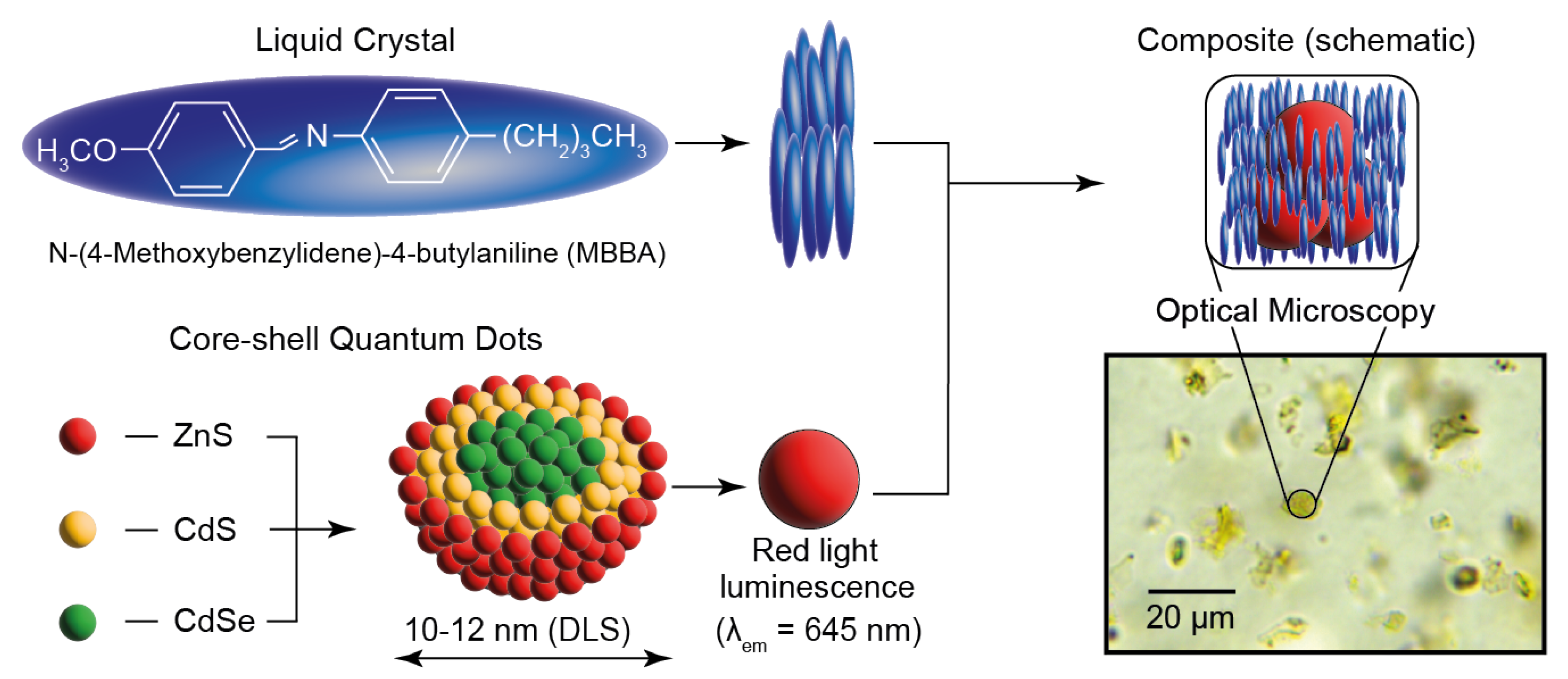
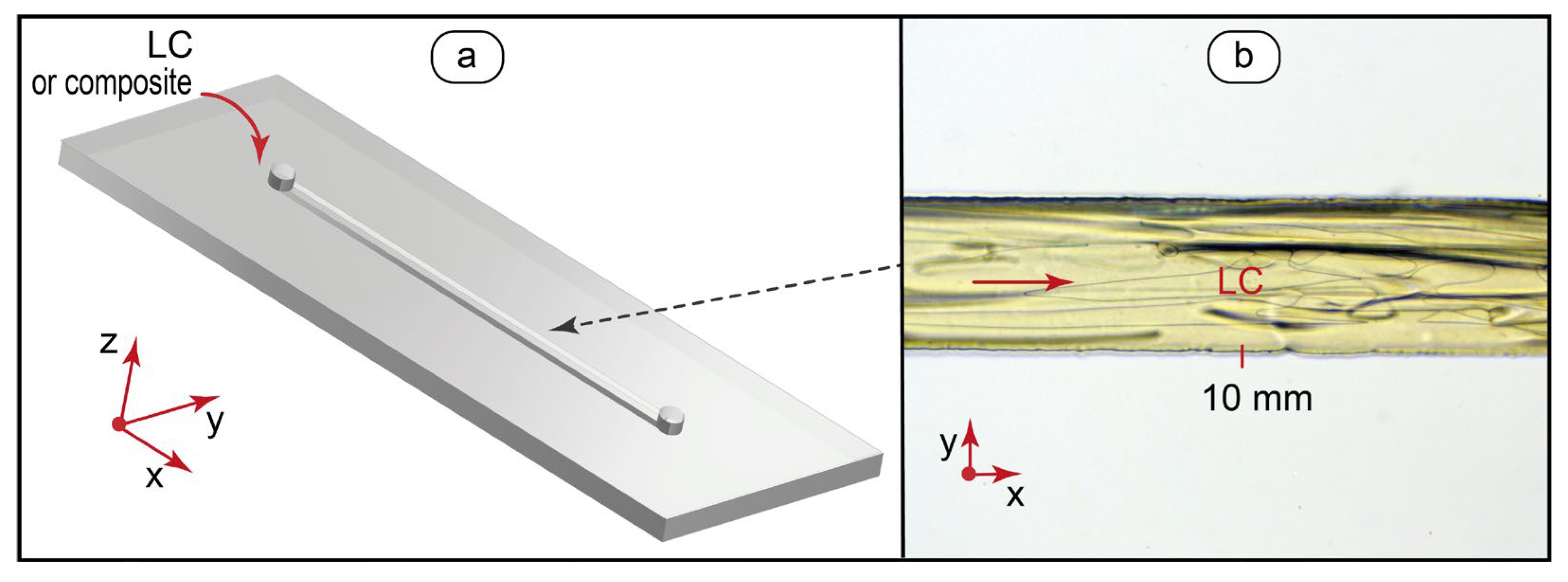


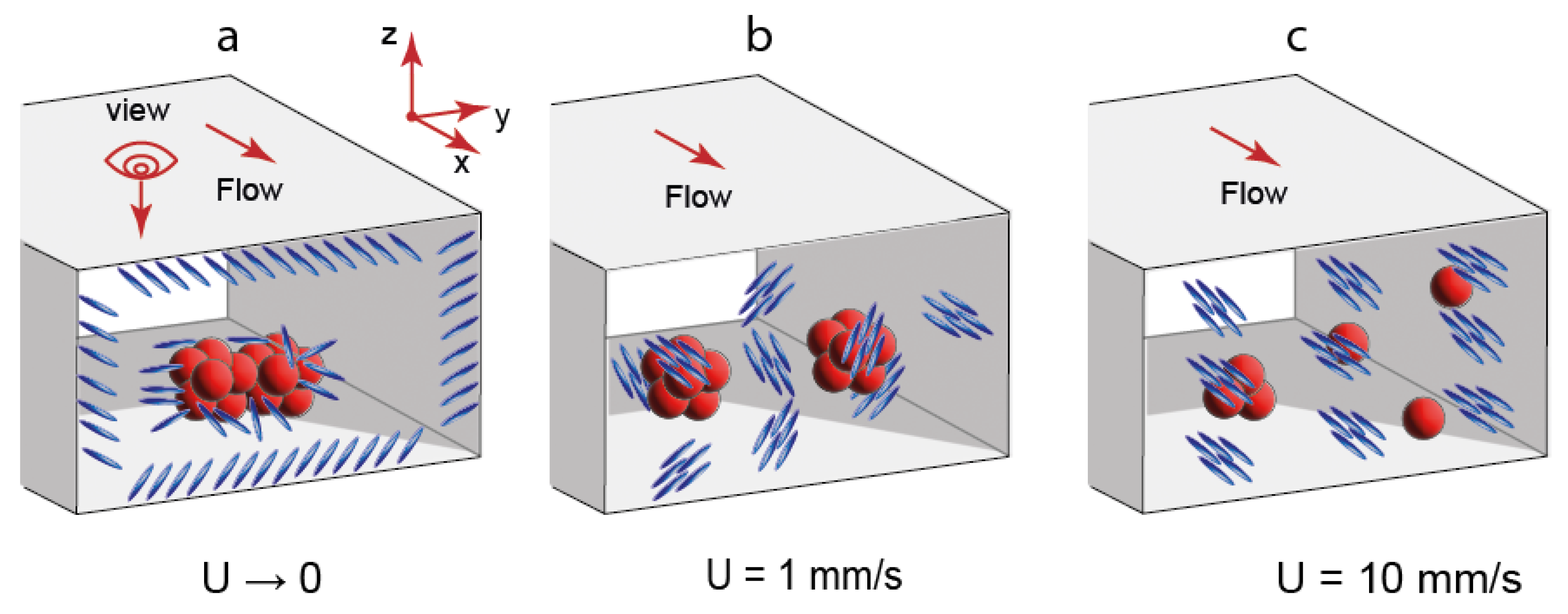
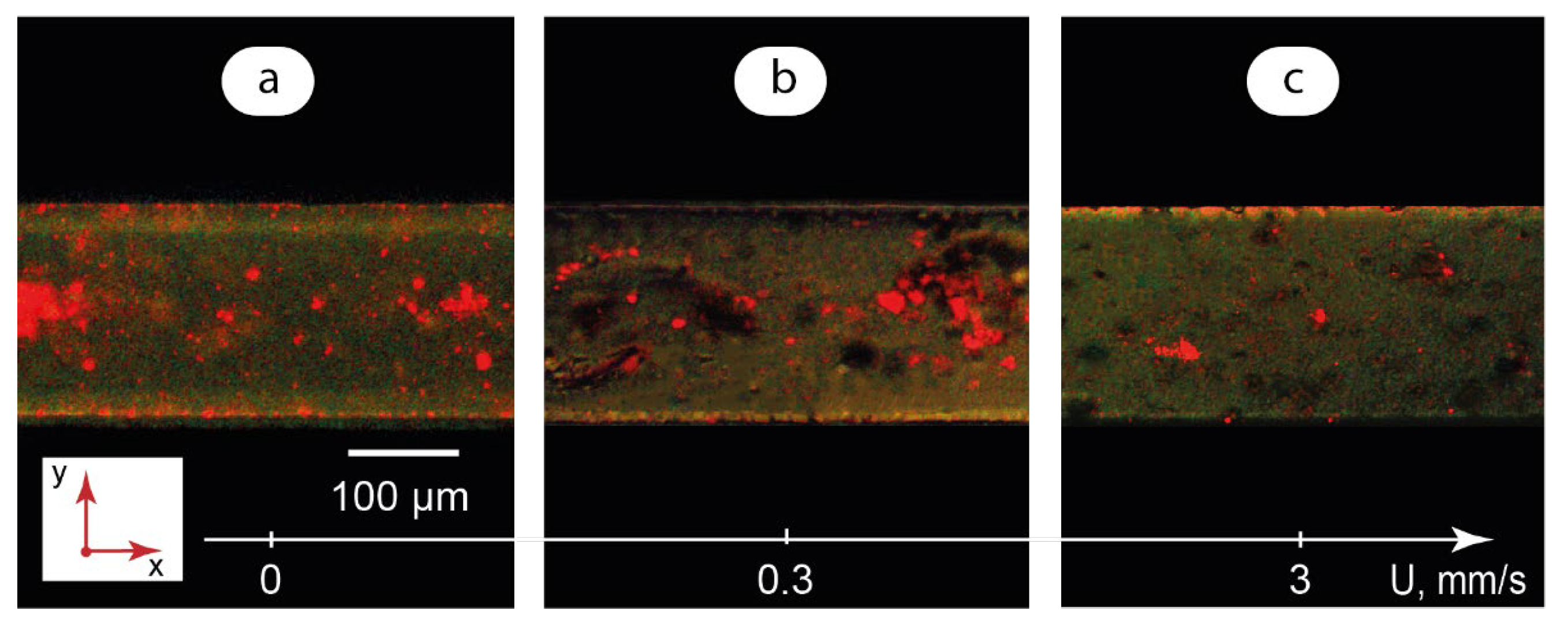

Disclaimer/Publisher’s Note: The statements, opinions and data contained in all publications are solely those of the individual author(s) and contributor(s) and not of MDPI and/or the editor(s). MDPI and/or the editor(s) disclaim responsibility for any injury to people or property resulting from any ideas, methods, instructions or products referred to in the content. |
© 2023 by the authors. Licensee MDPI, Basel, Switzerland. This article is an open access article distributed under the terms and conditions of the Creative Commons Attribution (CC BY) license (https://creativecommons.org/licenses/by/4.0/).
Share and Cite
Bezrukov, A.; Galyametdinov, Y. Dynamic Flow Control over Optical Properties of Liquid Crystal–Quantum Dot Hybrids in Microfluidic Devices. Micromachines 2023, 14, 990. https://doi.org/10.3390/mi14050990
Bezrukov A, Galyametdinov Y. Dynamic Flow Control over Optical Properties of Liquid Crystal–Quantum Dot Hybrids in Microfluidic Devices. Micromachines. 2023; 14(5):990. https://doi.org/10.3390/mi14050990
Chicago/Turabian StyleBezrukov, Artem, and Yury Galyametdinov. 2023. "Dynamic Flow Control over Optical Properties of Liquid Crystal–Quantum Dot Hybrids in Microfluidic Devices" Micromachines 14, no. 5: 990. https://doi.org/10.3390/mi14050990
APA StyleBezrukov, A., & Galyametdinov, Y. (2023). Dynamic Flow Control over Optical Properties of Liquid Crystal–Quantum Dot Hybrids in Microfluidic Devices. Micromachines, 14(5), 990. https://doi.org/10.3390/mi14050990




